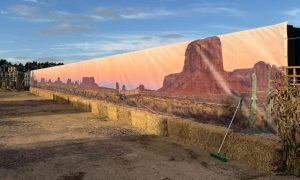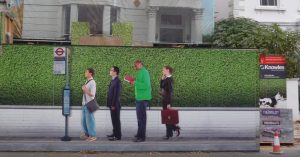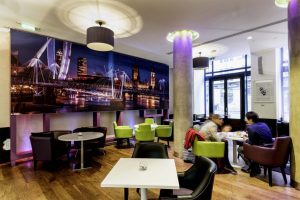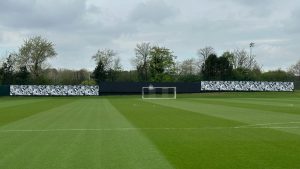Digitally printed artistic building wrap effectively hides the scaffolding and building site while the museum undergoes extensive renovations.

London, UK – Established in 1753 and located in central London, the British Museum is a monumental Greek Revival style building with four vast wings, 44 columns and a triangular pediment decorated by sculptures depicting The Progress of Civilisation. Housing a collection of over 13 million objects and welcoming almost six million visitors per year, the building is often in need of repair and renovations. The museum’s main entryway is, in fact, currently an unsightly mess of work tools, machinery and scaffolding. But visitors are completely unaware of this fact thanks to the beautifully illustrated artistic building wrap created by Project Print Management (PPM).
Artistic building wrap to cover the triangular pediment with a trompe l’oeil image
PPM was commissioned to cover the triangular pediment with a trompe l’oeil image during construction. Printed on plastic sheeting 40 meters long and 12 meters high, the image of the pediment and its sculpture is designed to scale with perfect colour and perspective in mind. The company was also asked to hide the scaffolding behind the pillars with Printed Scaffold Sheeting, which was digitally printed on to a mesh PVC material. This mesh, fire-retardant PVC is manufactured in Germany by Verseidag, a company well renowned as leaders in the industry.
According to Justin Murray, PPM’s owner, building wraps such as these are becoming increasingly popular. They serve the purpose of not only hiding construction, but also helping to reduce dust and noise, and additionally providing some protection to workers and machinery from wind, rain and snow.

It may seem like a simple concept, but the wraps are complex to create with a great many elements to consider. Murray has to work closely not only with the architect of the renovation but also with the scaffolding company Wellmax, who need to install a sub-frame to accommodate the wrap. And getting it to look realistic with the right scale, perspective and colour is a highly challenging task.
Murray explains that the British Museum also wanted printed scaffolding sheeting to cover the bulk of the scaffolding instead of using debris netting.
“We colour matched the Portland stone and printed a solid colour. Then we added a sky effect to the roof area. But we do have the expertise to print any design such as stone, wood or brick and blend it into the background if needed.”
Printed scaffold sheeting to be hung vertically, unlike debris netting which is usually installed horizontally
The British Museum project also required the printed scaffold sheeting to be hung vertically, unlike debris netting which is usually installed horizontally. The sheets were finished with a pocket at the bottom for a scaffold pole to hold the sheet in place. Almost 50 panels totalling 2,800 square meters were used, making it one of the largest building wraps produced this year.
With 25 years of experience, Murray and his team are proud to have worked on some of London’s finest buildings, the British Museum included.
“We feel honoured to work on this project for the British Museum,” says Murray. “Restoration work is always unwelcome although entirely necessary, and our artistic building wrap goes a long way to minimizing the disruption for everyone concerned.”

For more information on artist building wrap please visit here. For our latest print projects please visit our blog page.
https://accesspoint.org.uk/preserving-british-history/





